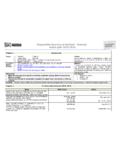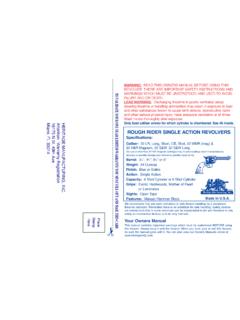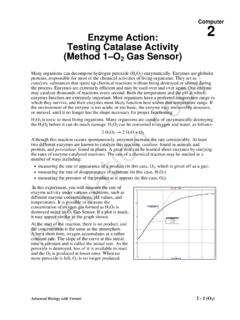Transcription of The Mechanism of Action of Isothiazolone Biocides
1 Terry M. WilliamsABSTRACTI sothiazolone Biocides have proven efficacy and per-formance for microbial control in a variety of industrialwater treatment applications. Understanding themechanism of Action of industrial Biocides is importantin optimizing their use and combating resistance ifencountered. Isothiazolones utilize a two-step mecha-nism involving rapid inhibition (minutes) of growth andmetabolism, followed by irreversible cell damageresulting in loss of viability (hours). Cells are inhibitedby disruption of the metabolic pathways involvingdehydrogenase enzymes.
2 Critical physiological func-tions are rapidly inhibited in microbes, includinggrowth, respiration (oxygen consumption), and energygeneration (adenosine triphosphate synthesis). Celldeath results from the destruction of protein thiols andproduction of free radicals. The rate and extent ofkilling may be enhanced by various adjuvants includingsurfactants. This unique Mechanism results in a broadspectrum of activity, low use levels, and difficulty inattaining resistance. INTRODUCTIONI sothiazolone Biocides are widely used in a variety ofindustrial water treatment applications for control of micro-bial growth and biofouling [1].
3 The most frequently usedproduct is a 3:1 ratio of 5-chloro-2-methyl-4-isothiazolin-3-one (CMIT) and 2-methyl-4-isothiazolin-3-one (MIT).CMIT/MIT has broad spectrum efficacy versus bacteria,algae, and fungi. 1,2-benzisothiazolin-3-one (BIT) productshave been used in a limited range of industrial applicationsrequiring long-term preservation for bacterial control,including mineral processing and closed loop cooling sys-tems. Recently, a new microemulsion technology wasintroduced using 4,5-dichloro-2-n-octyl-4-isothiazolin-3- one (DCOIT) as an algicide for cooling water treatment anda fungicide for paper mill applications [2].
4 The most recentisothiazolone biocide for industrial water systems is basedon the MIT active ingredient alone and is targeted at long-term preservative applications with higher pH and tem-perature the mode of Action of industrial Biocides isimportant in optimizing their use and combating resistanceif encountered [3]. The antimicrobial effects of isothia-zolone Biocides have been broadly defined for CMIT andBIT [1,3 11]. These Biocides function as electrophilicagents, reacting with critical enzymes to inhibit growth andmetabolism, with cell death occurring after several hourscontact.
5 Less is known about the Mechanism of MIT andDCOIT. Oxidizers also function as electrophiles, with rapidspeed of killing, whereas quats and other membraneactive agents tend to directly affect cell membranes(Figure1) [3].The intent of this paper is to review the Mechanism ofaction of Isothiazolone Biocides across a range of microor-ganisms, including cell binding, inhibition of growth andrespiration, interaction with proteins and enzymes, andsubsequent loss of viability (cell death). The impact of themechanism will be discussed relative to monitoring effi-cacy, resistance and ways to improve their AND METHODSB iocides EvaluatedThe chemical structures of the Isothiazolone biocidesdescribed in this paper are shown in Figure2.
6 CMIT/MITis composed of a 3:1 ratio of CMIT:MIT at a final concen-tration of active ingredient (ai).(1)DCOIT is for-mulated at a concentration of ingredient in awater-based microemulsion.(2)MIT biocide is a solution in water.(3)OIT biocide is a 5%active solu-The Mechanism of Action of Isothiazolone Biocides 2007 by PowerPlantChemistry GmbH. All rights Mechanism of Action of Isothiazolone Biocides14 PowerPlant Chemistry 2007, 9(1)(1)Kathon WT Microbicide (Rohm and Haas Company;Philadelphia, PA)(2)Klarix 4000 Microbicide (Rohm and Haas Company;Philadelphia, PA)(3)Kordek MLX Microbicide (Rohm and Haas Company.)
7 Philadelphia, PA)Figure 1: Mechanism of Action of industrial ,2-dibromo-2-cyanoacetamideBNPD2-bromo-2 -nitropropane-1,3-diolThe Mechanism of Action of Isothiazolone Biocides15 PowerPlant Chemistry 2007, 9(1)tion in propylene glycol and was included for biocide concentrations in this paper are reported on anactive ingredient basis. The Isothiazolone Biocides de-scribed in this paper are manufactured by Rohm and HaasCompany. Solutions of CMIT and MIT were prepared indistilled water and kept frozen until use. DCOIT and OITwere diluted in 50:50 (v:v) ethanol:water.
8 All other chemi-cals used were reagent grade or the highest availablepurity, and most were obtained from Sigma ChemicalCompany, St. Louis, MO, unless stated and Culture ConditionsPure cultures were obtained from the American TypeCultureCollection (ATCC, Rockville, MD, USA). Sac-charomyces cerevisiaeATCC 4921, Aspergillus nigerATCC6275, and Pseudomonas aeruginosaATCC 13388 weregrown in Sabouraud's dextrose broth (SDB), potato dex-trose broth (PDB), and M9G minimal salts media with glu-cose at 30 C, respectively [4]. Escherichia coliATCC25922 and Pseudomonas aeruginosaATCC 15442 werealso obtained from ATCC and were routinely grown in M9 Gmedia.
9 Cultures were incubated at 37 C (E. coli) or 30 C(P. aeruginosa).Transport and Binding of Isothiazolone Biocides withS. CerevisiaeCellsCell binding studies were conducted to determine theassociation of the Isothiazolone biocide with microbialcells. Chemostat-grown cells of S. cerevisiaewereused in these studies in the presence of CMIT, MIT,and DCOIT Biocides . Cells were treated with radio-labeled biocide and radioactivity levels were usedto determine the uptake of the biocide into cultures were grown in New BrunswickScientific BioFlow chemostats at 30 C and an agi-tation rate of 100 revolutions per minute.
10 S. cere-visiaewas grown in SDB + % glucose at a gen-eration rate of h. Cells were harvested in sterile50 mL Oak Ridge tubes, washed, and resus-pended to an absorbance (660 nm) of in10 mM PO4buffer (pH ). Samples were frozenand protein content was was determined using the Bio-Rad auto-mated microassay in 96-well microplates using theBiomek 2000 Workstation. The plates were incu-bated at room temperature for 5 to 60 density (OD) at 650 nm was measuredusing a Molecular Devices Thermomax MicroPlateReader. Data was analyzed using the MolecularDevices SoftMax of Growth Inhibition and SusceptibilityThe lowest concentration of biocide required to inhibitgrowth was determined by a high resolution minimuminhibitory concentration (MIC) test.







